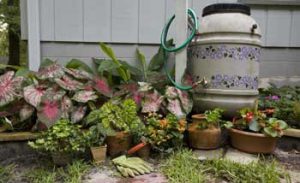It’s a struggle to manage our Panhandle landscapes, especially over the late spring-summer months. Just remember, small adjustments can mean significant impacts in conserving water.
Some homeowners are not aware that watering plants too much can have as much of an ill effect as not watering enough. Shallow rooted plants, as well as newly set plants can easily become water stressed. Some people lightly water their plants each day. With this practice, one is only watering an inch or less of the topsoil. Most plant roots are deeper than this. Instead of a light watering every day, soaking the plant a few times a week is best. A soil that has been soaked will retain moisture for several days. This is a very good practice for young plants. In contrast, some people soak their plants to often. This essential drowns the roots by eliminating vital oxygen in the root zone. This can also cause root rot. Signs of overwatering are where leaves turn brown at the tips or edges, as well as leaf drop.
Figure 1: Rain Barrel.
Credit: UF/IFAS Florida-Friendly Landscaping.
The following are tips from the UF/IFAS Florida-Friendly Landscape Program. These tips will help you conserve water and provides best management practices for your landscape.
- Choose the right plant for the right place: Be sure to place plants in your landscape that match conditions with plant needs.
- Water Thoughtfully: Of course, follow water restrictions first and foremost. Water early in the morning and water when plants and turfgrass start to wilt. Refrain from watering in the late afternoon or evening. This is when insects and diseases are most active.
- Perform regular irrigation maintenance: Remember, an irrigation system is only effective if it is maintained regularly. Check for and repair leaks. If using a pop-up heads for turfgrass, point heads away from driveways and sidewalks.
- Calibrate turfgrass irrigation system: Ideal amount of water to apply to turfgrass is ½”- ¾”. A simple test can be done to calibrate. Place a coffee or tuna cans throughout the landscape. Run the irrigation system for 30 minutes. Average the depth of the water containers. Adjust running time to apply the ½”- ¾” rate.
- Use microirrigation in gardens and individual plants: Drip or microspray irrigation systems apply water directly to the root system with limited surface evaporation.
- Make a rain barrel: Rain barrels are an inexpensive way to capture rainwater from your roof. This can translate into a big impact on your water bill as well.
- Mulch plants: Mulch helps keep moisture in the root zone. Two to three inches in depth, for a few feet in diameter will work well for trees, shrubs, flowers and vegetables.
- Mow correctly: Mowing your grass at the highest recommended length is key. Be sure to cut no more than 1/3 of the leaf blade each time you mow. Keep mowing blades sharp as dull cuts often cause grass to be prone to disease.
- Be a weather watcher: Wait at least 24 hours after a rainfall event to water. If rain is in the forecast, wait 48 hours until irrigating. Use a rain gauge or install a rain shut-off device to monitor irrigation scheduling.
Following these tips will help you conserve water and maximize watering efforts in your landscape. For more information on water conservation principles please contact your local county extension office.
Supporting information can be found at the UF/IFAS Center for Landscape Conservation & Ecology’s Drought Toolkit: http://clce.ifas.ufl.edu/drought_toolkit/
UF/IFAS Extension is an Equal Opportunity Institution.
- Panhandle Outdoors Live: Woodlot Management - March 11, 2024
- Poisonous Plant? Take a Closer Look, but not too Close - October 25, 2023
- Panhandle Scallop Sitter Volunteers Needed for Gulf, Bay & Franklin! - April 25, 2023

